When the Boulder&Lead format was announced, athletes and fans reacted to it as being biased towards Lead athletes. The argument was that it was easy for a strong lead climber to score high on the lead route, getting 90+ points, while for a boulderer, it is more of a gamble to score over 90 points because sometimes Boulder rounds are won with only two tops. But this hasn’t turned out, and at the Shanghai OQS, it was better to be a Female Boulderer or a Male Lead climber.
Like in other sports like mountain biking and skiing, Boulder and Lead competitions have a new field of play created for athletes to compete in for each competition. And like everything created by humans, there are going to be biases in the setting, from the style of the climbs to the difficulty level across the round.
Competition routesetting is an incredibly hard job, with routesetters working 12+ hour days during the competition to put up the climbs, tweak them for the next round and take them down again for the next round. The fact that they create balanced rounds most of the time is an indicator of how good they are. Yet in the Bouklder&Lead format, they face a new challenge: balancing the difficulty between the disciplines, which will be especially difficult at the Olympics when different teams of routesetters are setting Boulder and Lead.
Ideally, we would want the disciplines to be of equal difficulty to give every athlete a fair chance of scoring points in each round, independent of their discipline preference. But this is unrealistic. The playing field is going to change from competition to competition, just like it does at IFSC World Cups. The Paris 2024 combined format rewards those who are the best-combined athletes. This is a big change from the previous combined format at Tokyo 2020, which rewarded the specialists more due to the multiplicative scoring based on athletes’ ranks.
In this article, we look at who benefited from the biases in the routesetting at the Shanghai OQS. We look at the selection bias created by the imbalances between the disciplines. We finish by looking at whether the routesetting in Shanghai met the expectation the IFSC had for the scoring.
What was the Boulder&Lead scoring system again?
When the new combined Boulder&Lead format was created, the IFSC needed to create a new point scoring system. They decided to create one which rewarded athletes for their performance on each climb instead of their relative performance. The latest version of this system was introduced at the Bern World Championship after test events in Morioka, Japan, and the 2022 European Championship in Munich.
Each round is made up of 4 boulders and 1 lead route, with up to 100 points available in each discipline. Each boulder has three scoring points with the introduction of a second low zone. Athletes score 5 points for the low zone, 10 points for the high zone and 25 points for the top. They lose 0.1 points for each failed attempt.
In Lead, athletes get points depending on how high they get on the route. The top 40 holds are scored, with the top 10 worth 4 points each. The 10 below are worth 3 points each, the 10 below are worth 2 points each, and the first 10 scoring holds are worth 1 point each. An athlete’s score is the sum of the holds they reach. If they make forward progress towards the next hold but fall, they are awarded a plus “+” score worth an additional 0.1 points.
The points added together from each discipline give an athlete’s total points for a round.
So far, the highest score any athlete has scored using the scoring system was 199.9 by Oceana Mackenzie in the Oceania Qualifier final round and by Chris Cosser in the African Qualifier semi-final round.
It was better to be a female boulderer or a male Lead climber in Shanghai
It was not difficult to see that it was better to be a good female Boulderer than a Lead climber in Shanghai. Four women topped all 4 boulders in qualification. Another four topped all the boulders in the semi-final, all scoring over 98 points in each. In contrast, no female athlete scored higher than 72 in Lead in either the qualification or semi-final round. For the men, it was harder to see the Lead bias. However, Lee Doyhun and Alberto Ginés López both traded first and second place throughout the competition.
To look deeper, we compare some simple statistics:
- The top score for each discipline across each round,
- The range of the scores, the difference between the highest and lowest scores, and
- The standard deviation, a measure of the variation of scores around the average (mean) score.
A similar top score means that the best athletes in each discipline were able to maximise their points equally. The range and standard deviation look at the spread of scores in different ways, with the range looking at the ends of the distribution while the standard deviation looks at the spread. If each discipline has similar standard deviations, then they will contribute equally to the overall score.
Across all three of these, we see a bias towards Female Boulderers and Male Lead climbers across the rounds.
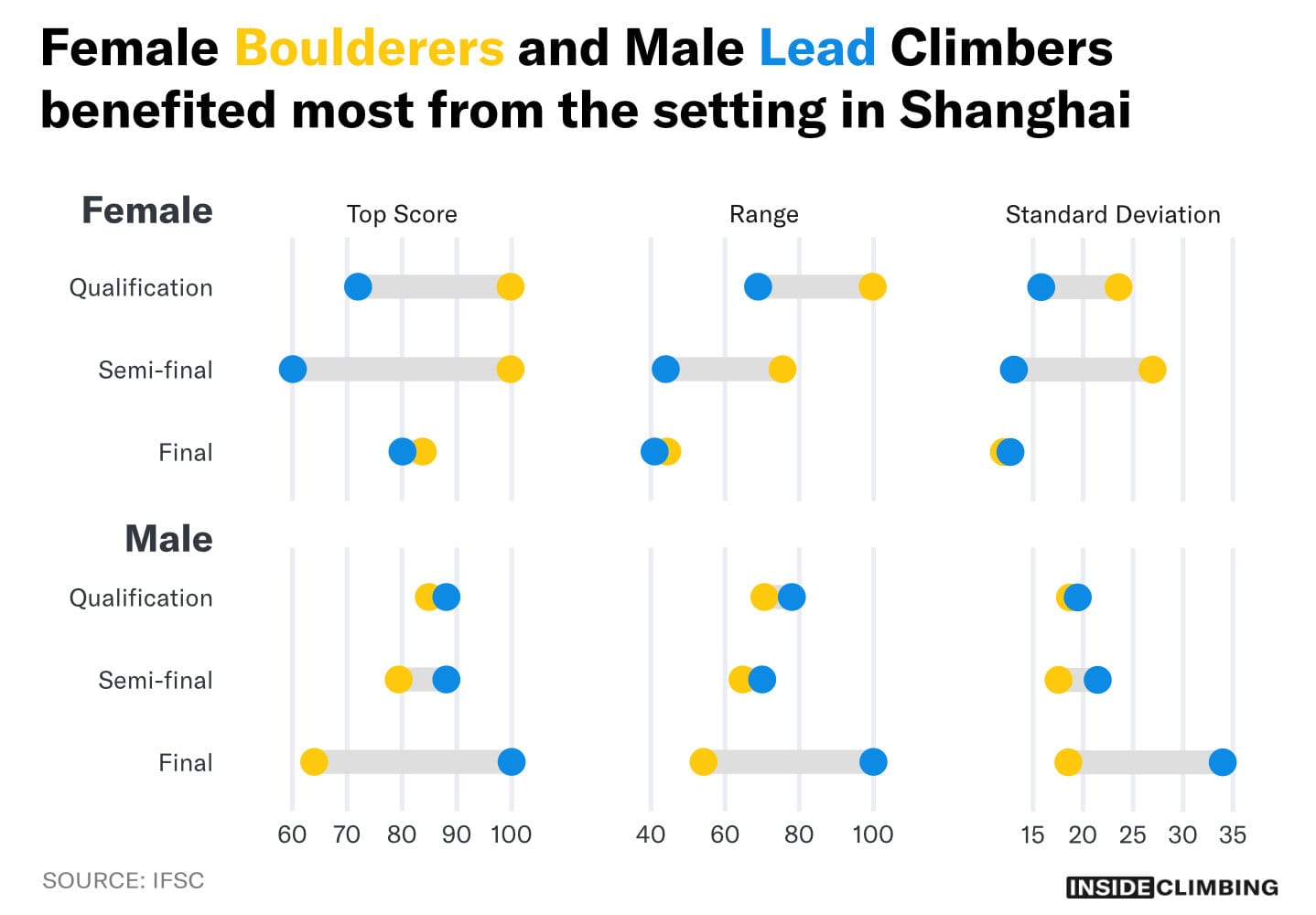
The Female final was a lot closer across these statistics. Still, the qualification and semi-final were heavily biased towards boulderers. The statistics in the Male rounds were close in the qualification and semi-finals but diverged in the final. Lead climbers benefited from a hard Boulder round, which Adam Ondra won with only two tops.
You can see this when you look closely at the distribution of female and male competition.
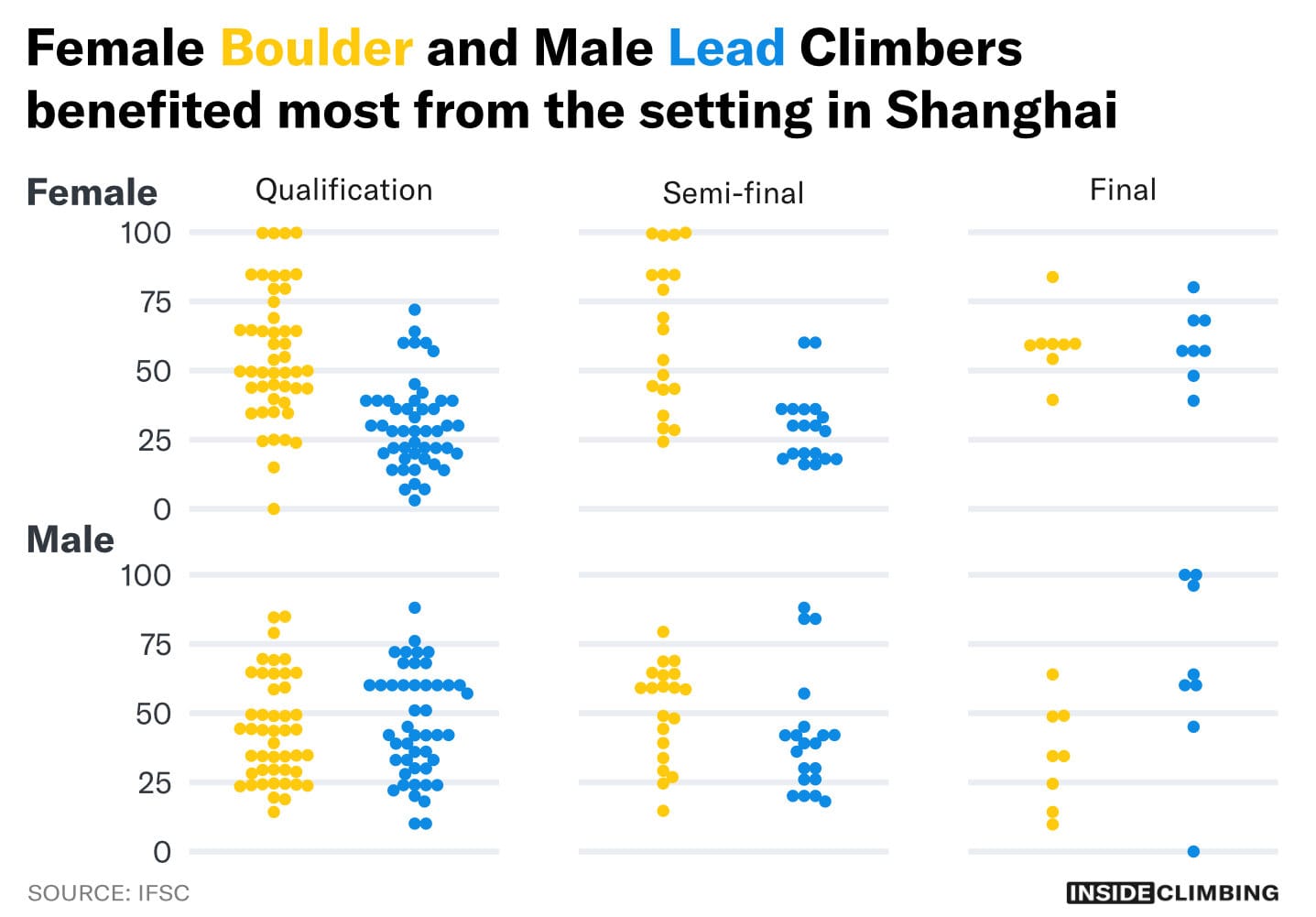
The most successful rounds were the male qualification, semi-final rounds, and the female final. The close female final created an exciting final, with Seo Chaehyun needing to score two holds higher to take the win.
Selection bias of the setting affected who progressed to the next round
There is another effect the bias in the routesetting had on the competition: selecting who progressed to the next round. The routesetting in Shanghai for the female qualification and semi-final round excluded more athletes from the Lead discipline than Boulder.
| Sex | Round | # Higher Boulder score | # Higher Lead Score | Equal Scores |
|---|---|---|---|---|
| Female | Qualification | 41 | 7 | 0 |
| Female | Semi-final | 17 | 2 | 1 |
| Female | Final | 4 | 4 | 0 |
| Male | Qualification | 22 | 24 | 0 |
| Male | Semi-final | 15 | 5 | 0 |
| Male | Final | 3 | 5 | 0 |
41 athletes scored higher in Boulder than Lead, while only 7 athletes scored higher in Lead. Those who scored higher in the Lead in qualification were Kim Jain, Seo Chaehyun, Molly Thompson-Smith, Laura Rogora, Aleksandra Totkova, Kume Nonoha, and Tegwen Oates. This trend continued in the semi-final, where only 2 athletes, Kim Jain and Manon Hilly, scored higher in Lead than Boulder.
This imbalance had a big effect on who progressed to the next round.
| Sex | Round Progressed to | # Higher boulder score | # Higher Lead score |
|---|---|---|---|
| Female | Semi-final | 16 | 4 |
| Female | Final | 8 | 0 |
| Male | Semi-final | 9 | 11 |
| Male | Final | 5 | 3 |
Because the majority of male athletes scored higher in Boulder than lead in the semi-final round, those who excelled at lead climbing and could keep up in Boulder could capitalise.
The 3 male athletes who scored higher in Lead than Boulder were Lee Dohyun, Albeto Ginés López, and Sasch Lehmann, and all 3 reached the final. Both Lee and Ginéz López finished in the top 10 in the Boulder round, while Lehmann finished 17th in Boulder and joint 2nd in Lead to move into the final.
Did Shanghai meet the IFSC expectations?
Before the Bern 2023 World Championship, the IFSC published guidelines publically around what they expected from the routesetters in the Boulder&Lead format, including the difficulty level of the Boulder and Lead rounds in terms of the number of tops.
To create a field of play where, based on their performances, competitors are ranked effectively and with a final result that minimises tied scores; in Boulder with a good spread on number of tops achieved (a total number of tops should be between 34–46 tops in qualification round; 23–31 in semi-finals and between 13–20 in the finals); the Lead routes should be set in such a level of difficulty that only one top is possible (in qualification rounds and also in the finals); The number of moves in each route should be between 40 and 50.
In Shanghai, there were only 2 tops of any Lead route in the competition, both in the Male final.
| Sex | Boulder Round | # Tops | Expected # Tops |
|---|---|---|---|
| Female | Final | 16 | 13 – 20 |
| Female | Semi-final | 37 | 23 – 31 |
| Female | Qualification | 79 | 34 – 46 |
| Male | Final | 7 | 13 – 20 |
| Male | Semi-final | 27 | 23 – 31 |
| Male | Qualification | 44 | 34 – 46 |
You can see that the Male Boulder final round was slightly too hard, but the semi-final and the qualification rounds were spot on. The opposite was true for the women, with the final round just perfect, while the semi-final and qualification rounds had more tops. The qualification round had nearly double the number of tops the IFSC wanted.
The IFSC also published guidance on the distribution of scores across each discipline, which ideally are the same across each discipline.
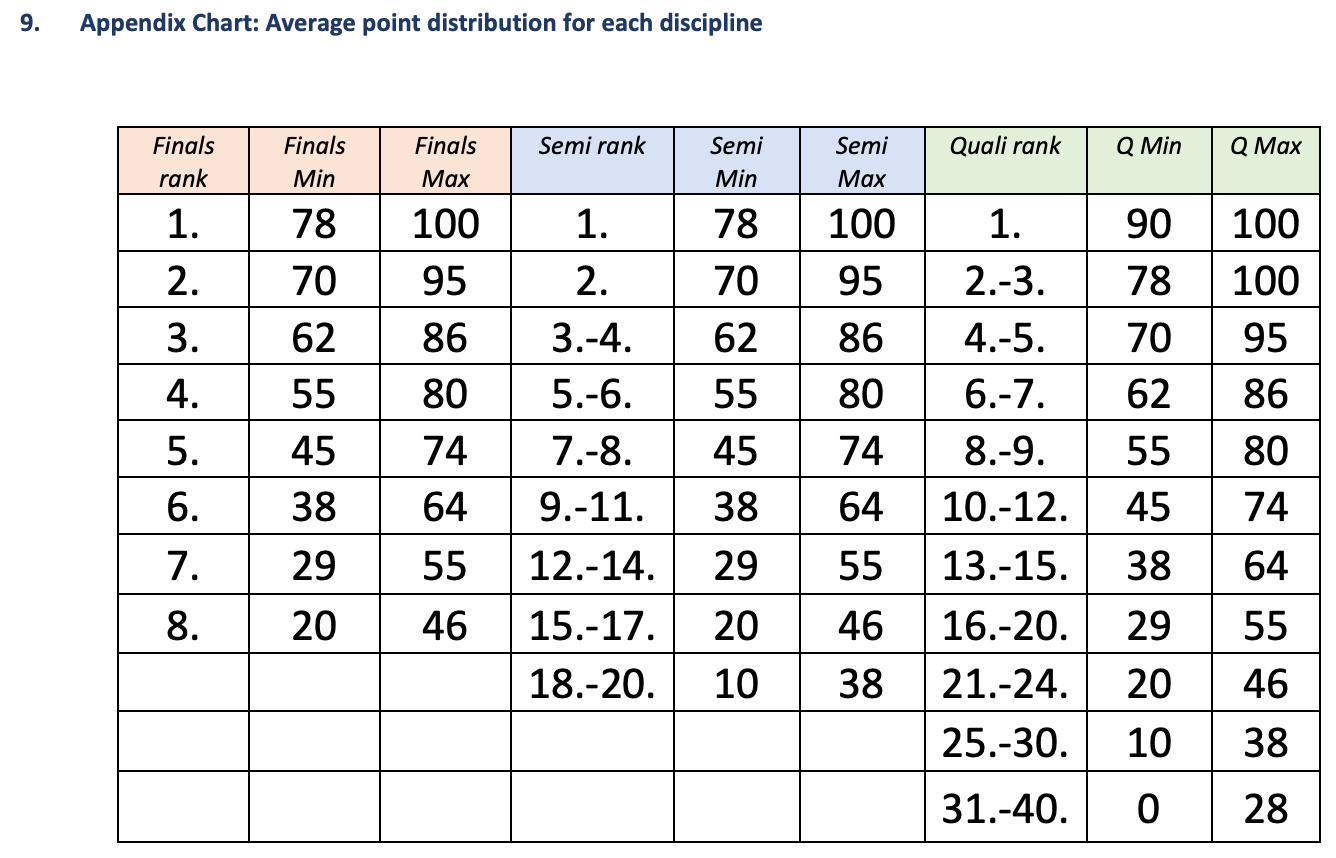
This scoring guidance leads to distributions that are skewed to the left for the qualification and semi-final rounds and to the right for the final.
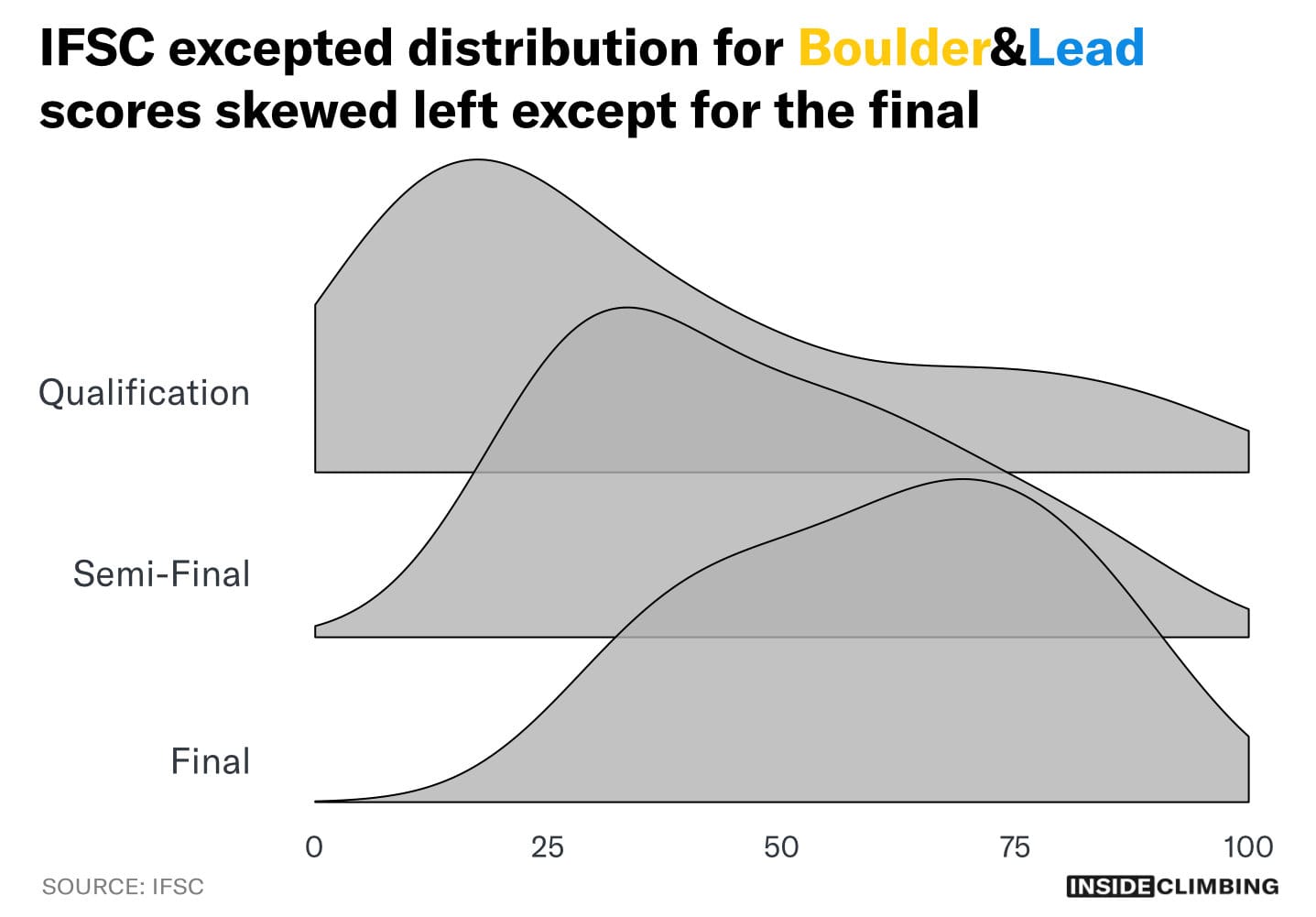
The final round skew of distributions to the right suggests the IFSC want the routesetters to set a higher scoring round for the final while taking into account that the eight athletes in the final are the best in the competition.
These expectations are overly optimistic compared to the reality of Shanghai.
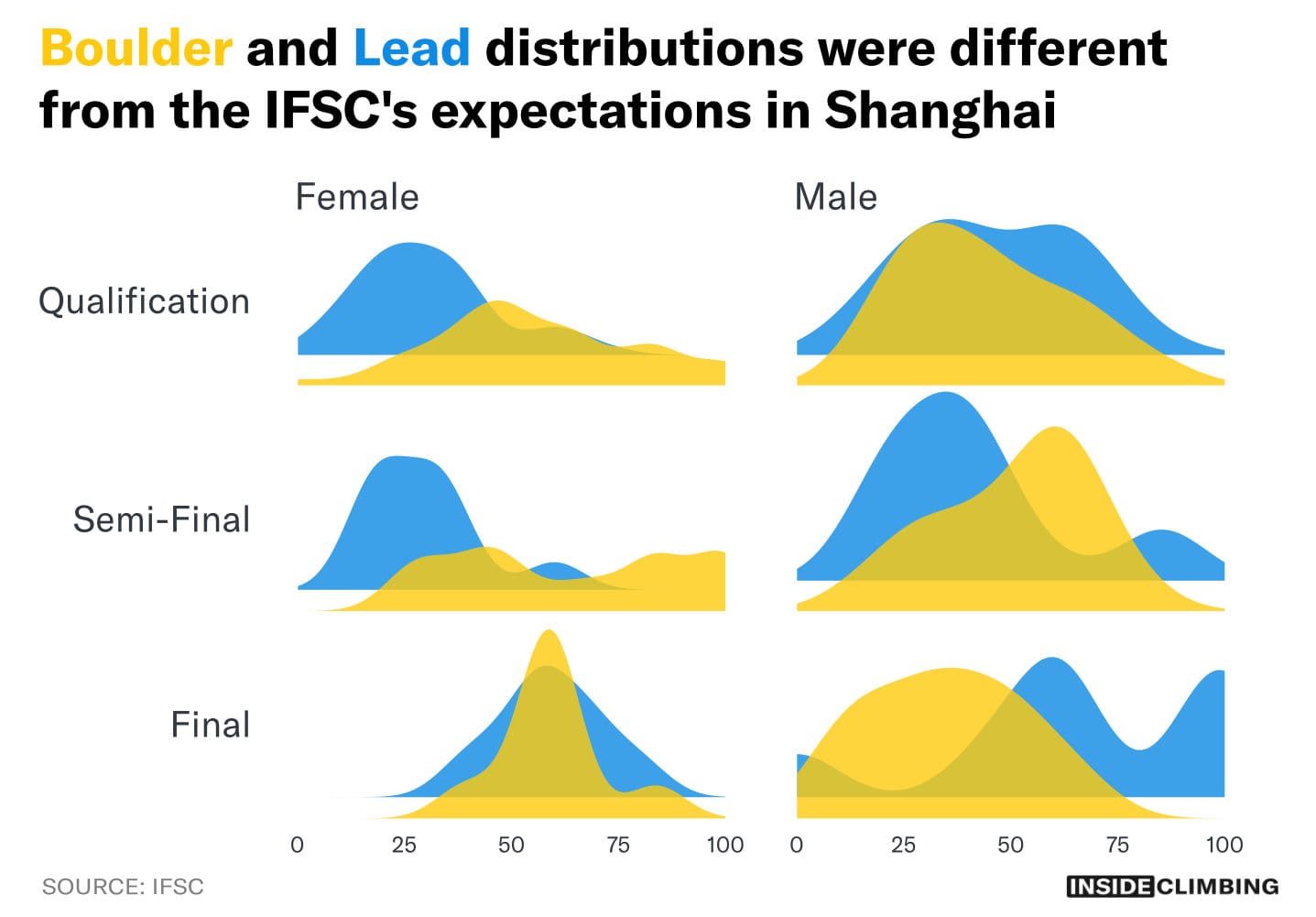
The Lead rounds were far closer to the expected results than the Boulder rounds. However, the female lead distributions tailed off faster as athletes scored lower. Otherwise, the scores were very different from the IFSC guidelines and between disciplines. The only round in which the distributions between the disciplines were similar was the Female Final.
Conclusion
The introduction of points in any sport enables athletes to win in different ways. In Boulder&Lead, you can score more points by getting all the high zones than topping one boulder. You can potentially make up for a poor Boulder performance with a strong Lead performance. However, athletes must contend with the inevitable biases in the routesetting, with the format rewarding consistency over specialising in one discipline.
Jessica Pilz exemplified this in the 2023 World Championship. She finished 3rd in Boulder and 4th in Lead in the final, but she finished second overall due to the number of points she scored in each discipline.
There is no guarantee that athletes can make up for a poor round in one of the disciplines in the other. As we saw in Shanghai, even if you can win your speciality, you still need to be in the top half of the points in your other discipline to get on the podium.
But as interesting as this is, there are only two more competitions left in this format: the Budapest OQS and the Paris Olympics. After the Paris Olympics, much like after the Tokyo Olympics, the format will likely be consigned to the history books as Sport Climbing looks towards getting three sets of medals, one for each discipline, as a core sport at the LA 2028 Olympics.





